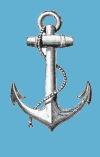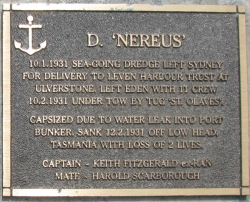 |
Tasmanian Seafarers' Memorial
|
 |
Nereus (1931)
The plaque reads ...
 D. 'Nereus"
D. 'Nereus"
10.1.1931going dredge left Sydney
for delivery to Leven Harbour Trust at
Ulverstone. Left Eden with 11 crew
10.2.1931 under tow by tug 'St Olaves'.
Capsized due to water lkeak into port
bunker, sank 12.2.1931 off Low Head,
Tasmania with loss of 2 lives.
Captain ~ Keith Fitzgerald ex RAN
Mate ~ Harold Scarborough
The lives of Keith Fitzgerald and Harold Scarborough, Captain and Mate respectively, were lost when the dredger Nereus foundered in Bass Strait on Thursday February 12, 1931 some 18 miles north of Tamar Heads. Ten survivors were rescued in an exhausted state by the crew of the towing tug St. Olaves .
The Nereus was a sea-going bucket dredger with a dredging capacity of 500 tons an hour, built in 1897, measuring 175.0 x 35.0 x 15.0. She was owned by the Penguin Salvage Co. Ltd. of Sydney and sold subject to delivery at Ulverstone to the Leven Harbour Trust for use in its harbour improvement scheme.
The Nereus left Sydney on January 10, 1931, Captain Muir, following docking and survey, under permit to proceed to sea under escort. A fishing launch convoyed her down the coast. Rough weather caused her to put into Jervis Bay for shelter, then several days later Nereus continued her journey, calling into Eden, NSW for coal. On leaving Eden, she struck adverse weather conditions with fierce headwinds so that her coal supplies dwindled alarmingly before she had progressed very far, and it was decided to return to Eden for more supplies.
Negotiations were then made to have the vessel towed to her destination by the tug St. Olaves which subsequently left Sydney on Monday February 9, commencing the long tow from Eden on February 10. The Nereus had seen crew changes at every stop on her journey south, thus it was under the command of Captain Fitzgerald that she left Eden.
The tug St. Olaves , Captain F. Hine, was a vessel of 468 tons. She was successfully towing the dredger some 800 feet aft, when the Nereus contacted her about 43 hours out of Eden and only a few hours from Ulverstone.
The tug received the flag signal shortly after 5.30 am, requesting the tug to slow down. The request was immediately complied with by the tug crew. Captain Hine saw the dredger heave over, turn bottom up and disappear. The Nereus had foundered at 5.50 am. The tow line was cut immediately and the tug steamed back to pick up survivors, retrieving 10 of the 11 persons from the water. The mate was believed to have gone down with the vessel. Harold Scarborough had joined the vessel at Jervis Bay as an able seaman and had been promoted to mate at Eden.
Attempts to revive the captain were unsuccessful. The coroner later found that Captain Fitzgerald had died as a result of drowning accelerated by head injuries. He was a native of Sydney who had served in the war in the Atlantic squadron of the Navy as a lieutenant. Upon his return to Australia he served for a number of years with the Adelaide Steamship Co. Ltd. as an officer on the freighters Dilga and Noora. He had joined the Nereus at Sydney as the mate.
The Court of Marine Inquiry found that the Nereus had been seaworthy when it left Sydney and that the foundering was not connected with the speed of the tug St. Olaves but rather the admission of water through the ship's plating in the port bunker, and through the port engine-room door after this had been stove in. The leak was not caused by towing but Nereus was as likely to have developed the leak had she been propelled by her own power. The Court considered that the loss of the dredge was attributable in some degree to the default of the engineer who should have remained in the engine-room where he would have been able to cope with the water influx, and the mate who, knowing there was a body of water in the engine-room between 2 and 3.00 am, should have at once notified the captain and engineer. The engineer was not called until 4.00 am when the vessel had a list of 10 degrees, yet even then he did not advise the navigating officers.
The Court placed on record its appreciation of the seamanship of Captain Hine, the officers and crew of the tug, St Olaves and the measures they took to save the lives of those on the dredge.
The Melbourne newspaper The Argus reported the following on Monday 16 February 1931 the sinking of the Dredge Nereus.
Engine-room Flooded.
SYDNEY, Sunday. - A graplic account of the foundering ot the dredge Nereus in Bass Strait, l8 miles north ot Low Head, Tasmania, early on Thursday morning was given by the master ot the tug St Olaves, Captain Hine, on the arrival of the tug in Sydney today. The St Olaves was towing the Nereus from Eden (NSW) to Ulverstone (T.) when the disaster occurred.
Captain Hine said that a choppy sea was running when shortly before 6 o'clock on Thursday morning the mate of the St Olaves, who was on the bridge, received a signal from Captain Fitzgerald, of the Nereus, to ease down. 'The mate called me," continued Captain Hine, "and I had hardly reached the bridge when the dredge turned over and sank. It was all over in an instant. We cut the towline and launched the lifeboat. Nine men were taken from the water, and shortly afterwards we recovered the body of Captain Fitzgerald. We saw no sign of the mate, Mr Scarborough, although we searched for more than two hours."
Survivors had affirmed that the foundering was due to the stoving in of the engine-room bulk head, through which the sea poured, flooding the engine-room.
A preliminary inquiry into the loss of the Nereus will be opened by the deputy director of navigation (Captain G. D. Williams) tomorrow.
![]()